News
Day Tripper | Olympia is worth a visit, whether or not the Legislature is in session
A couple of decades ago, in the middle of a Midwest road trip, I realized that I was fascinated by state capitals.
On that particular trip, we were traveling from Madison, Wisconsin, to Little Rock, Arkansas, with a stop at Springfield, Illinois. On the way, we visited a number of other cities and towns, both large and small. I think it was the social scientist/cultural anthropologist that dwells within me that observed how different state capitals are from other cities.
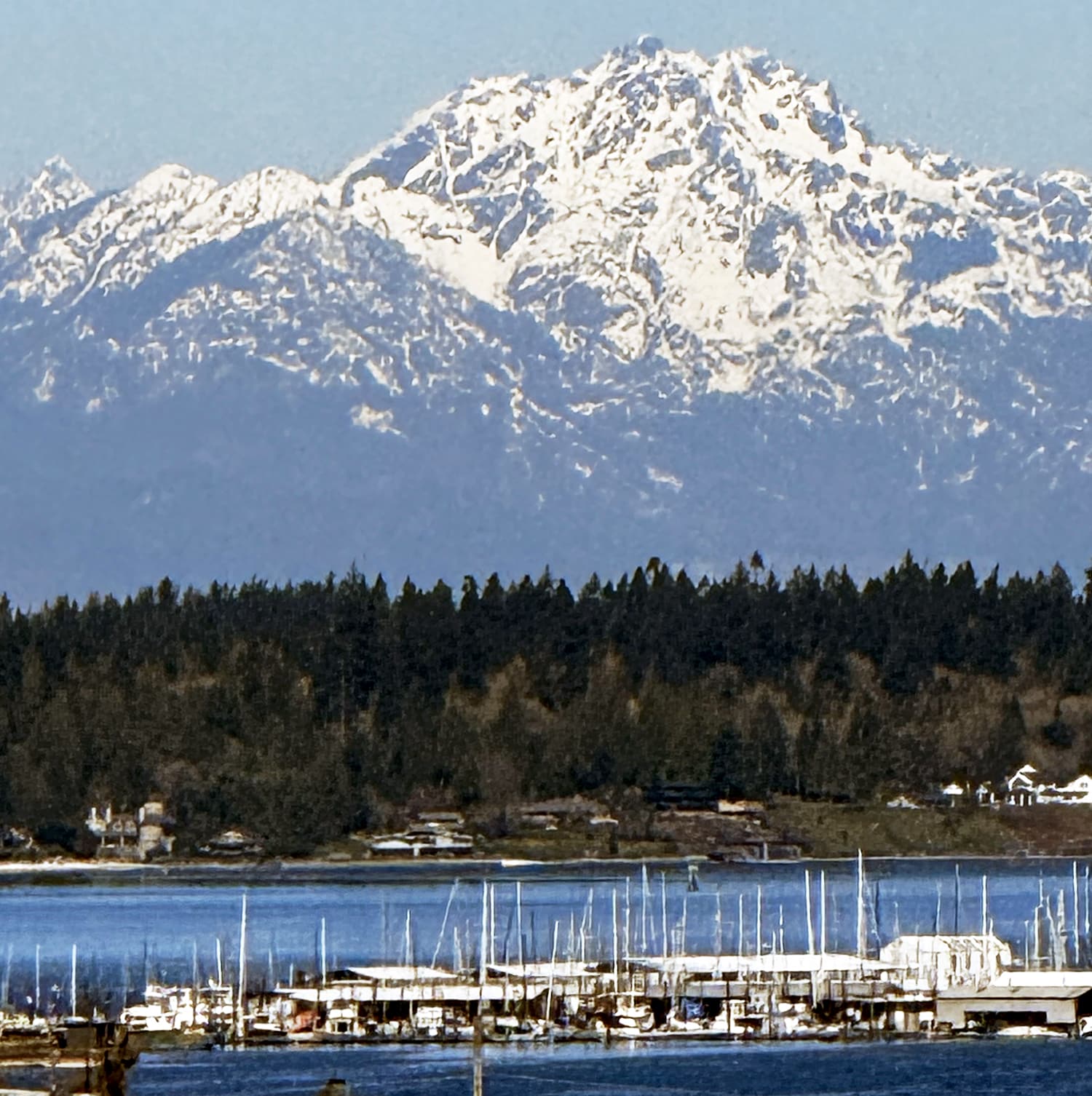
The view from Olympia. Photo by Mary Williams.
I have never come across a run-down capitol campus. The cities do the best they can to keep our current social issues well hidden, too. While there may be a homeless population in Olympia, it appears to be much more hidden than in cities like Seattle, Tacoma, Vancouver and Portland. My inner sociologist wants to expand my research on that topic, but this is a story about fun destinations and family travel, not investigative journalism.
I think it’s probably easier to keep a state capital in tip-top shape because they not only have resources of the city, but of the state and county in which they are located. Capitol gardens are well-maintained, statuary is abundant, and art is everywhere. Government leaders realize that the state capital is their front door, their community curb appeal, and they want to make the best impression possible.
Two Olympias
By now you’ve probably guessed that road trips are my thing. I’ve visited 42 of our 50 state capitals, including Olympia. I’ve been to or through our state capital many times. Even though I’ve been there so often, I had never really considered how much it differs from other nearby communities in the Pacific Northwest, or how much it’s like other state capitals until that fateful trip.
There are really two Olympias. From early January until sometime in the middle of spring, Olympia is inundated with activity. During the winter months, the Legislature is in session and the town buzzes with energy (and occasionally exhaustion).
If you enjoy the sometimes frenetic pace at which government operates, you’ll love visiting then – seeing government in action and all. But if you want to learn more about the town that is the seat of government — as opposed to the function, pace and operation of government — now is a great time to visit Olympia.
Just a couple of weeks ago, The Honorable Laurie Jinkins, Speaker of the Washington State House of Representatives, lowered the gavel on the last session of the 2024 Legislature.
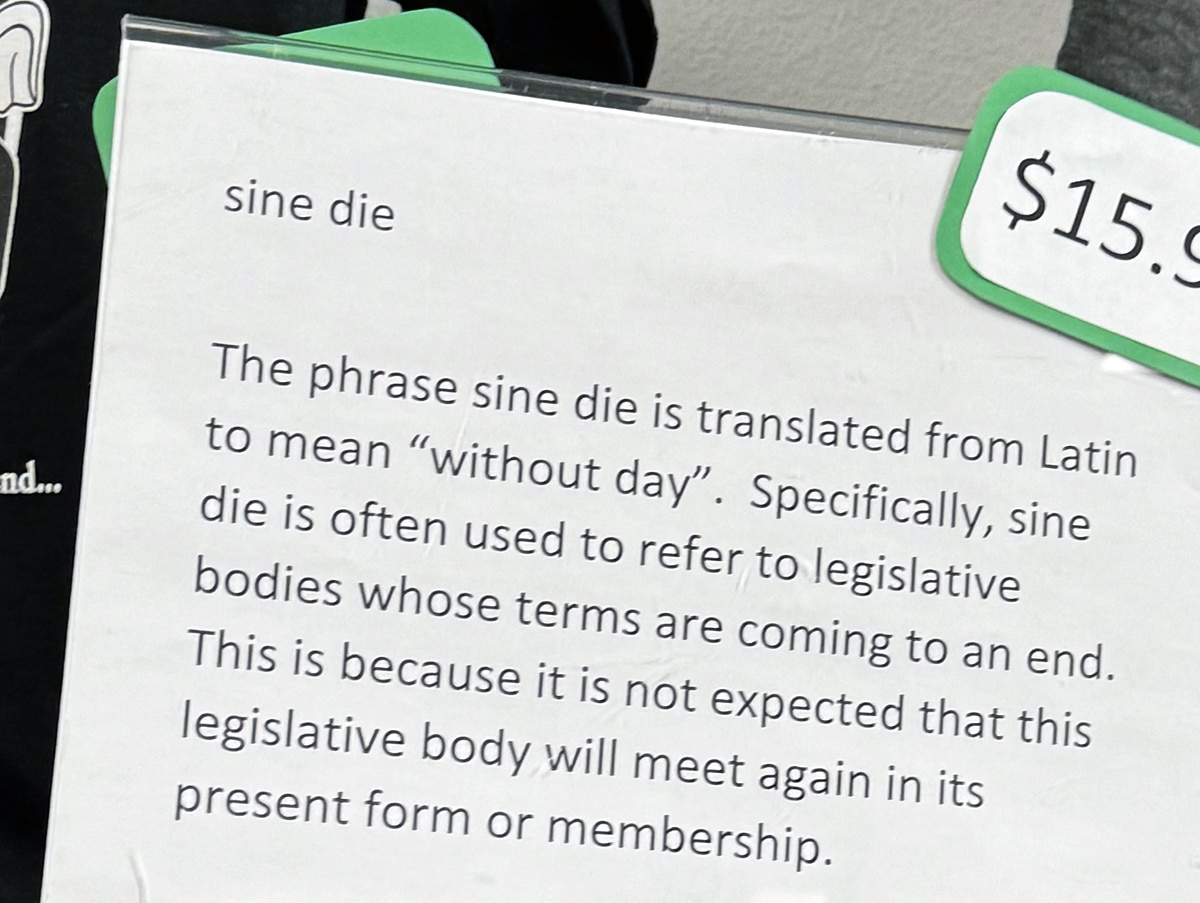
An explanation of the phrase Sine Die, which refers to the end of the legislative session. Photo by Mary Williams.
With Sine Die declared, the legislators, most of their staff, a cadre of lobbyists, and all the short-term employees who make the Legislature go cleaned out their desks, moved out of their temporary quarters, and hit the highway for home. If you’d looked out a capitol building window that weekend, all you’d have seen is a steady stream of taillights headed for the nearest freeway onramp. Look around now and you’ll see that traffic is lighter, sidewalks are mostly empty, and you can actually get a seat in your favorite restaurant or coffee shop.
The Capitol Building
Just about anyone who has driven south on I-5 through Olympia has seen our state’s capitol building. Sitting high on a hill just to the west of the freeway, at 287 feet high, it is the tallest self-supporting masonry dome in the United States and the fifth-tallest in the world.
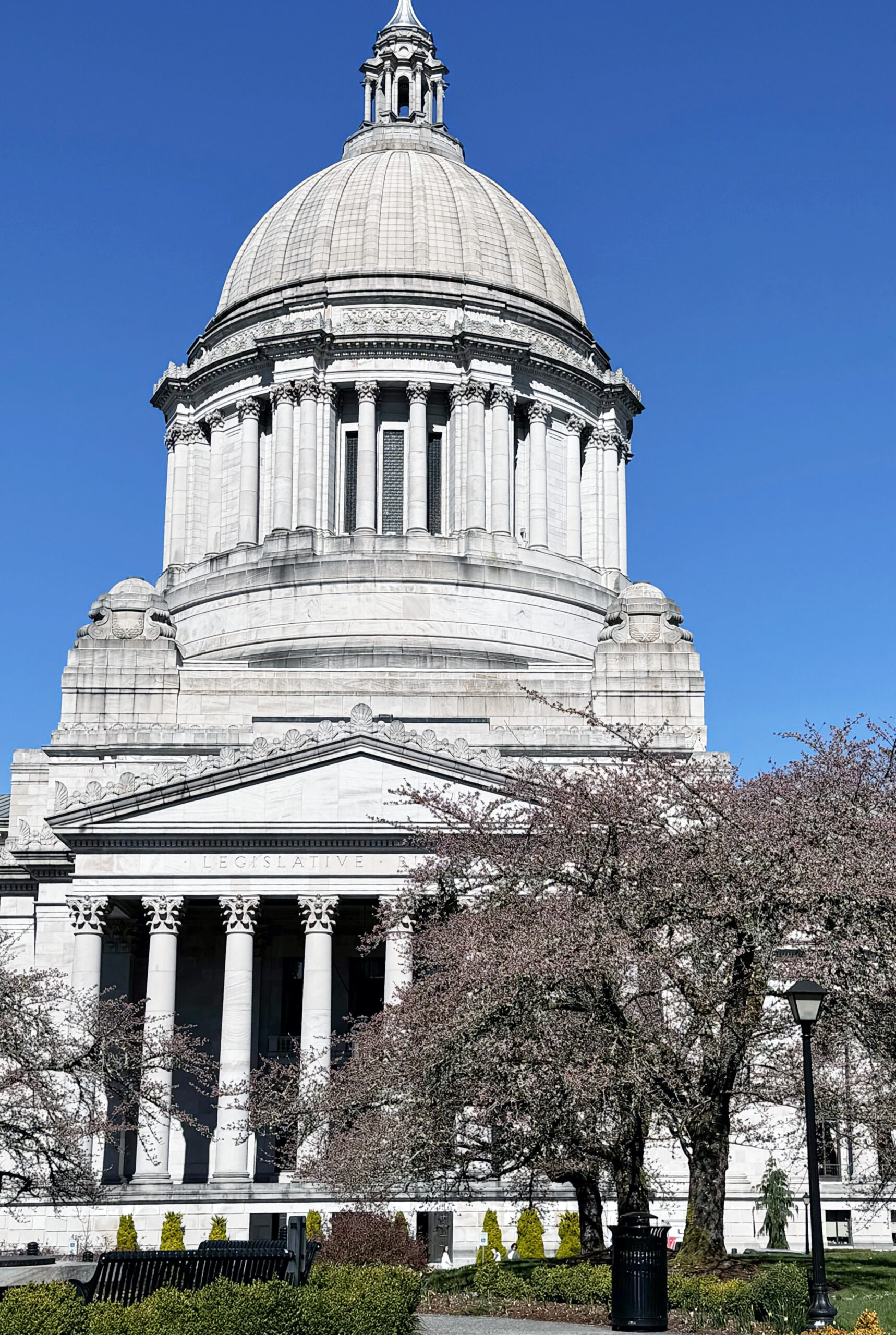
The Washington state Capitol building. Photo by Mary Williams.
Building it took more than 173 million pounds of stone, brick, concrete and steel. The building was completed in 1928 after six years of construction and added to the National Register of Historic Properties in 1979.
Since it opened, the legislative building has withstood three major earthquakes, the most recent being the Feb. 28, 2001, Nisqually quake. A three-year rehabilitation and earthquake-repair project was completed in 2004. The project added modern heating and cooling, plumbing, fire protection and state-of-the-art wireless technology systems, while maintaining historic features.
Thomas Dambo (the reclamation artist who created the PNW Trolls) take note: More than 80 percent of the construction waste — 8,000 tons of wood, concrete, paper, bricks, dirt, metal and drywall — was recycled. The project also placed 144 solar panels atop the fifth-floor roof of the building, the largest array of solar panels on a capitol in the United States.
If you’d like to learn more about the capitol building, all the statistics you’ll ever want are available here.
Of the many capitals I’ve visited, very few are open on weekends. I can count on one hand the number that are open to visitors on Sundays. In our state, even the legislative gift shop is open seven days a week. So far, I think that’s unique to Washington.
Getting There
Take Highway 16 to I-5. Go south to exit 105, then follow the signs to the Capitol.
Distance: 40 miles.
Capitol hours: 8 a.m. to 5 p.m. Monday through Friday; 11 a.m. to 4 p.m. Saturday and Sunday
The view from the capitol building is amazing. I don’t think I’ve visited any other legislative campus that has a setting as beautiful. Nestled against a mountain backdrop, there is a view of the water just about everywhere you look. But that’s not all.
The Governor’s Mansion
The governor’s mansion sits high on a hill adjacent to the legislative building and has an expansive view of Capitol Lake and the Olympic Mountains. Construction began in 1909 and took several years to complete.
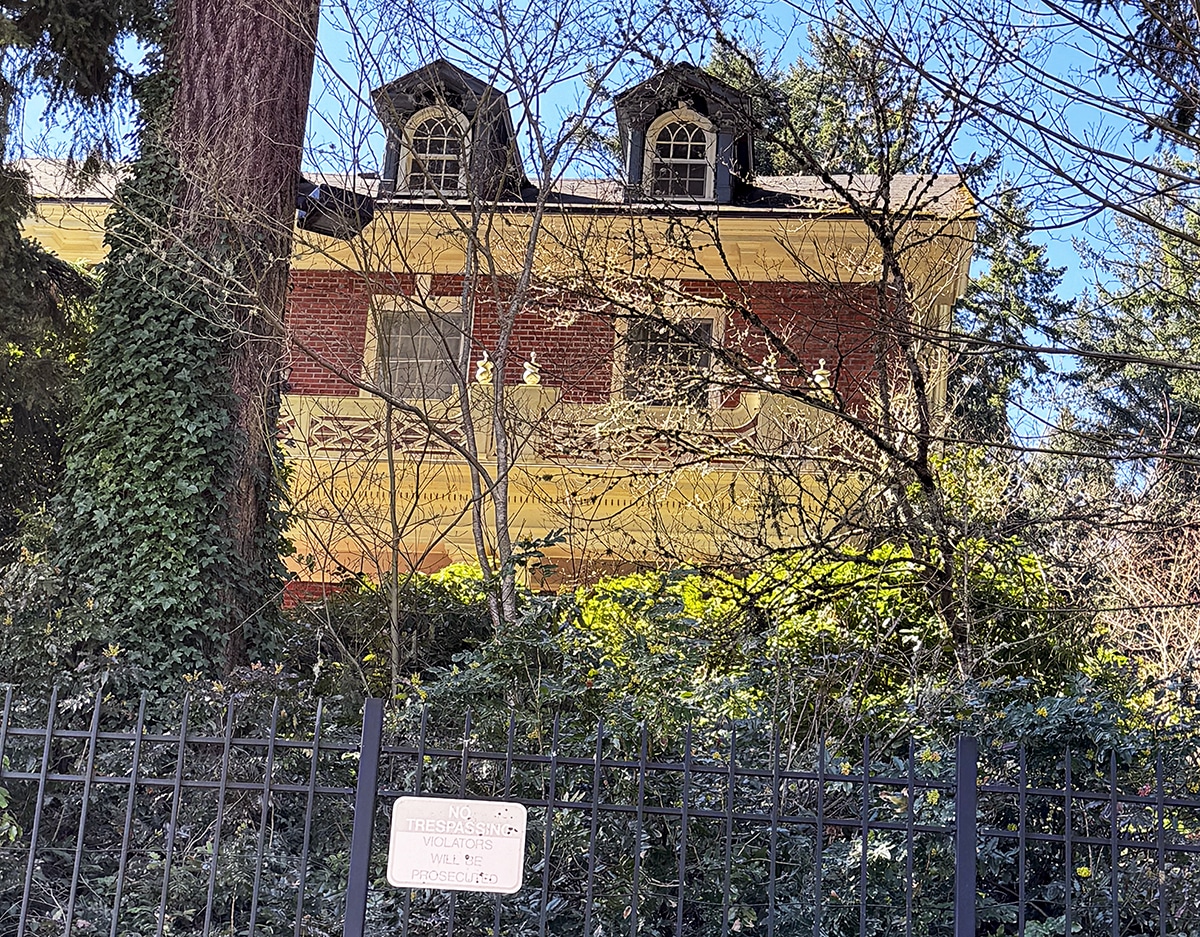
The Governor’s Mansion from outside a fence. Photo by Mary Williams.
Unfortunately, it was not well maintained and quickly fell into disrepair. During the tenure (1965-1977) of Gov. Dan Evans and his wife, Nancy Bell Evans, the Legislature funded a major renovation that included adding a number of new rooms.
Mrs. Evans also established a non-partisan 501(c)3 foundation, the Governor’s Mansion Foundation, to renovate and refurnish the public areas of the mansion as well as to provide funding for continued maintenance and operation. The Foundation now conducts tours on the first and second Wednesdays of the month. Reservations are required and can be made here. Due to security concerns, the mansion is completely fenced in and can only be viewed during a tour.
Lush landscaping
In February 2023, the ArbNet Arboretum Accreditation Program named Washington’s capitol campus an internationally accredited arboretum. The section nearest the legislative building and west of Capitol Way was designed by Olmstead Brothers landscaping firm. The firm was founded by Frederick Law Olmsted Sr., who also designed Central Park in New York and the U.S. Capitol grounds in Washington, D.C.
The state Department of Enterprise Services maintains the landscaping. They publish a brochure — available online or in racks around the campus — that guides visitors through a walking tour featuring more than 20 species of trees planted on the capitol grounds.
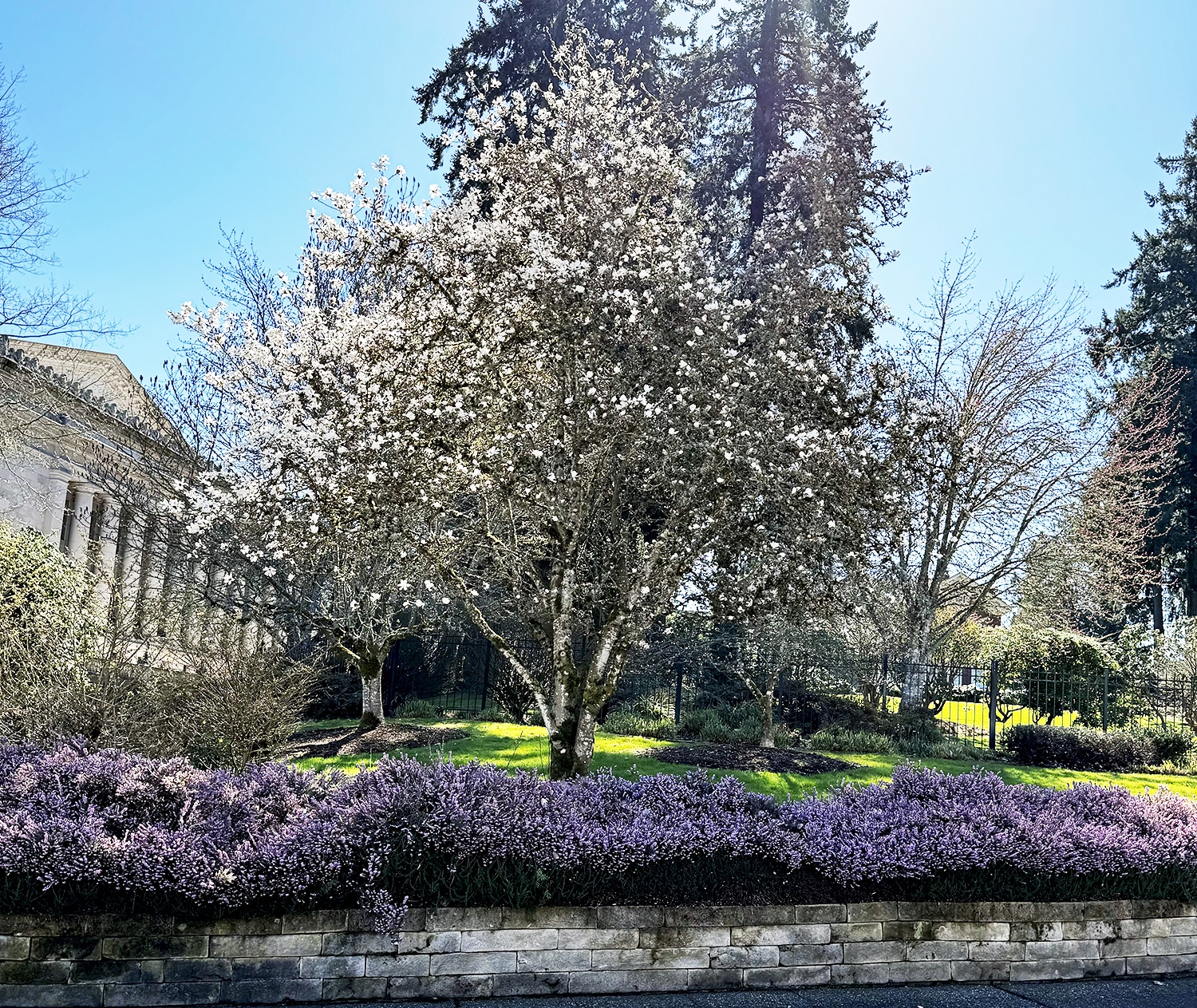
A tulip tree in bloom on the Washington Capitol Grounds. Photo by Mary Williams.
Memorials and statuary
The Department of Enterprise Services also inventories and maintains the more than 20 memorials that dot the capitol campus. The DES website provides a complete description and information about the acquisition, meaning and maintenance of the individual works of art. An interactive map and walking tour is available here.
It would certainly be easy to spend an entire day on the capitol campus. There are more things to look at and learn about than in many museums.
Particularly if you have kids with you, there is only so much you can take in and learn about in one day. And, we’re so close to this awesome place that it’s certainly worth visiting at least a couple of times a year. So right about now, it’s time to hit the road and learn about some of the other amazing places in Olympia that make it such a great city to visit. Here are a few of the other fun and interesting things to do in the Olympia area.
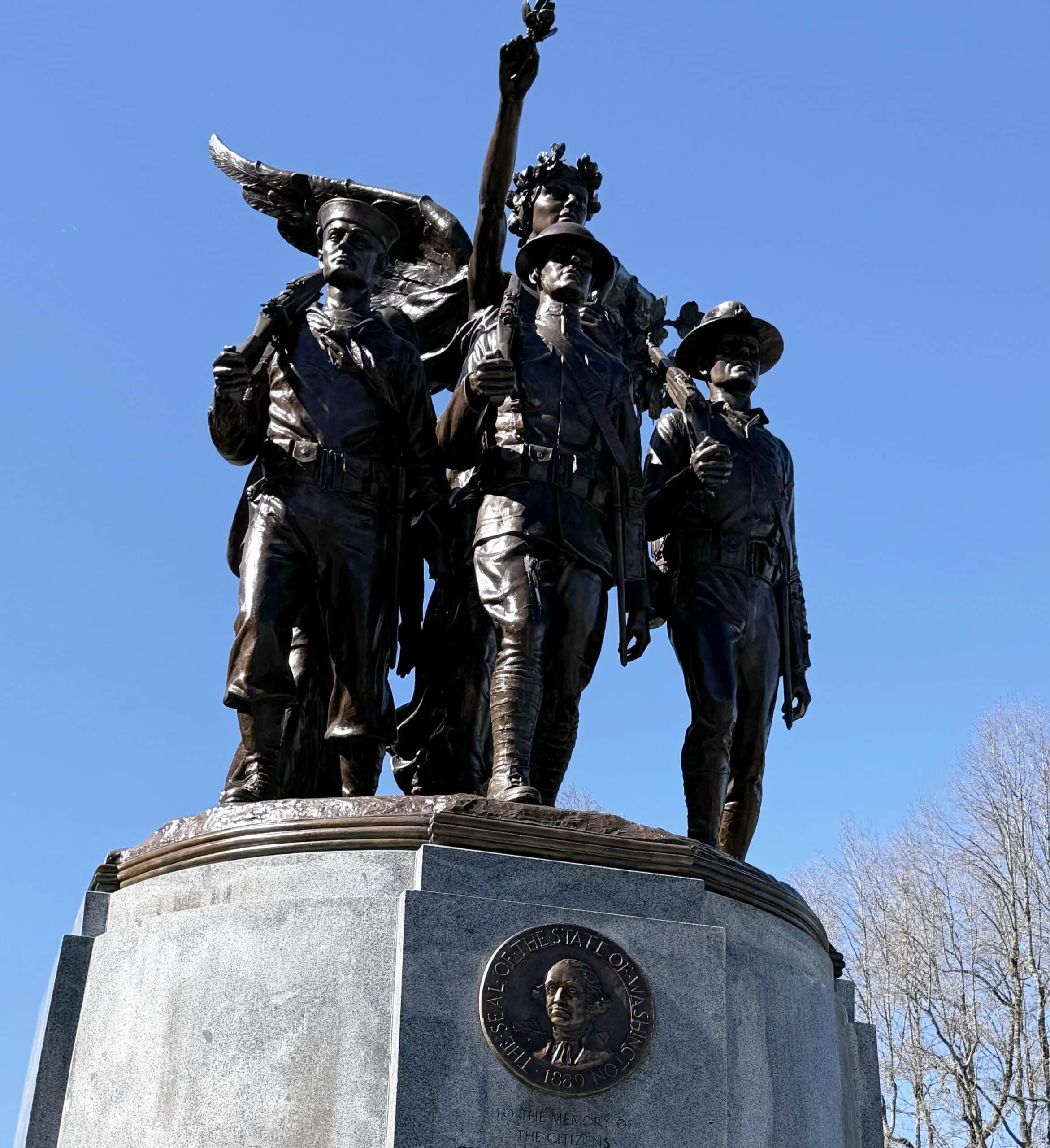
‘Winged Victory’ on the state Capitol grounds. Photo by Mary Williams.
Olympia Creative District
Creative Districts are a project of the Washington State Arts Commission, also known as ArtsWA. ArtsWA is a state agency, formed by the Legislature in 1961 to nurture and support the role of the arts in the lives of all Washingtonians. This award-winning program helps communities develop areas that are rich in cultural and economic activity, where people can enjoy arts and culture.
Olympia has just one of the 15 Creative Districts scattered throughout Washington state.
The Olympia Creative District is adjacent to the capitol campus. This map will help you locate the various dedicated regions within the district.
Walkability is a key component of the area. At the edges of the district are the Olympia Farmers Market and Swantown Boatyard & Marina.
Downtown’s entertainment and theater area, as well as the city’s traditional industrial area, make up the district. Businesses include an organic wool bedding workshop, manufacturing related shops such as welding and fabrication, an assortment of brewpubs and coffee roasters, and a theatrical costume shop. Much of the architectural style comes from the area’s former warehouses.
Anchor attractions include the Hands On Children’s Museum, the Washington Center for the Performing Arts, and the Capitol Theater. Kids will love the WET Science Center and Hands On Children’s Museum.
Get WET
The LOTT Clean Water Alliance owns and operates LOTT WET (Wastewater Education Technology) Science Center. The LOTT Alliance is a nonprofit providing wastewater management services for Lacey, Olympia, Tumwater and Thurston County — hence the acronym. It serves as a destination for people to build their understanding of all things water.
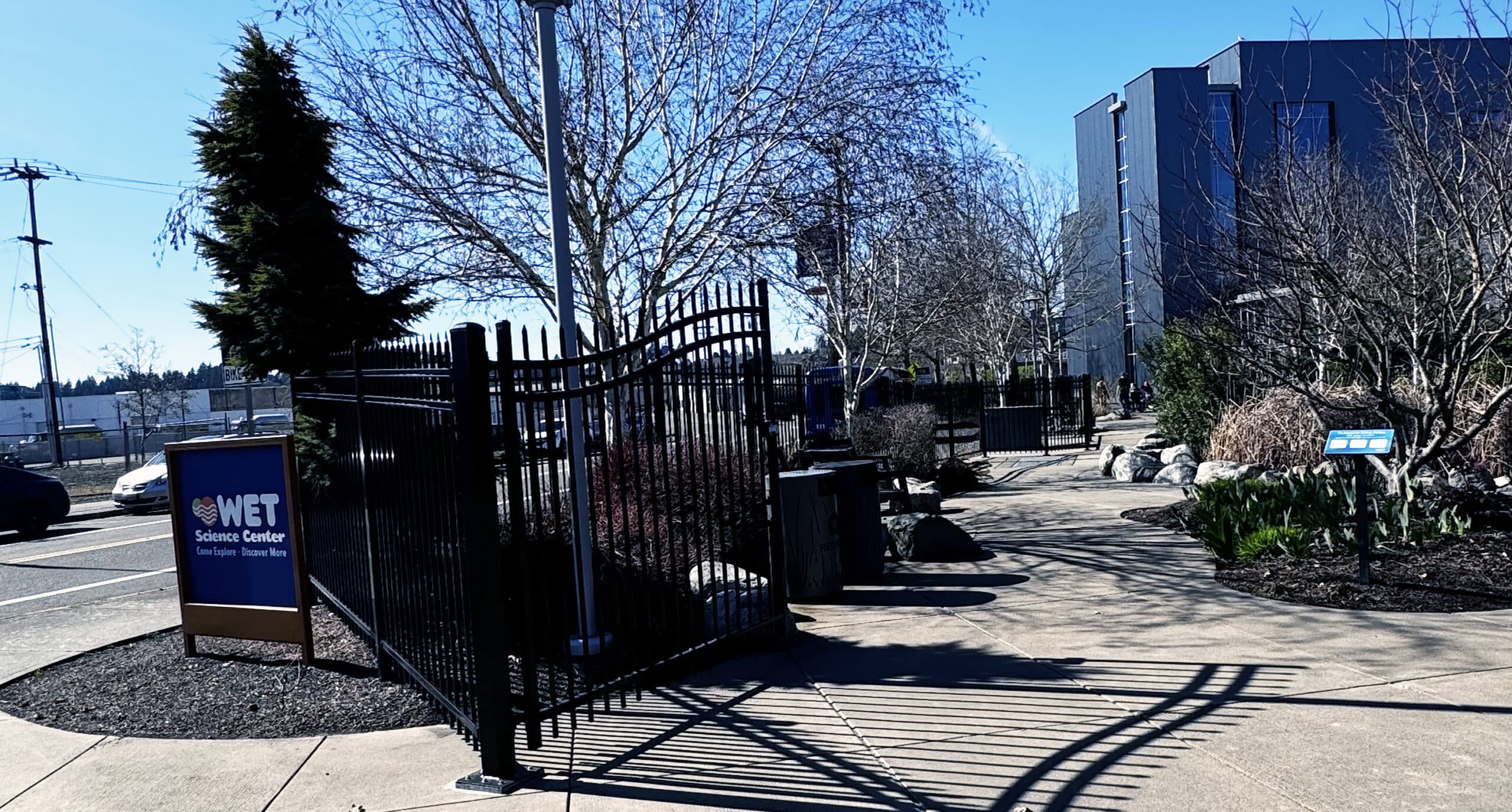
The WET — Wastewater Education Technology — Science Center in Olympia. Photo by Mary Williams.
Information on their website says that it should only take an hour or two to visit WET, and that while there are some exhibits of interest to young kids, the majority will be more appealing to the 8-and-older crowd, including adults.
WET is open from 10 a.m. to 4 p.m. Monday through Saturday.
Children’s museun
Hands On, primarily funded by credit union WSECU, is widely regarded as one of the best children’s museums in the region, some would say the country.
You can get the best sense of what its all about by checking out their website. Not only does it contain many pictures, it will provide you with information about tickets.
Visiting Hands On is not a spontaneous activity. Making reservations requires selecting a 2 hour block of time during which you must arrive. Once inside, you can stay as long as you’d like (or until they close at 5 p.m., whichever comes first).
Hands On is located directly across the street from WET at 414 Jefferson St.
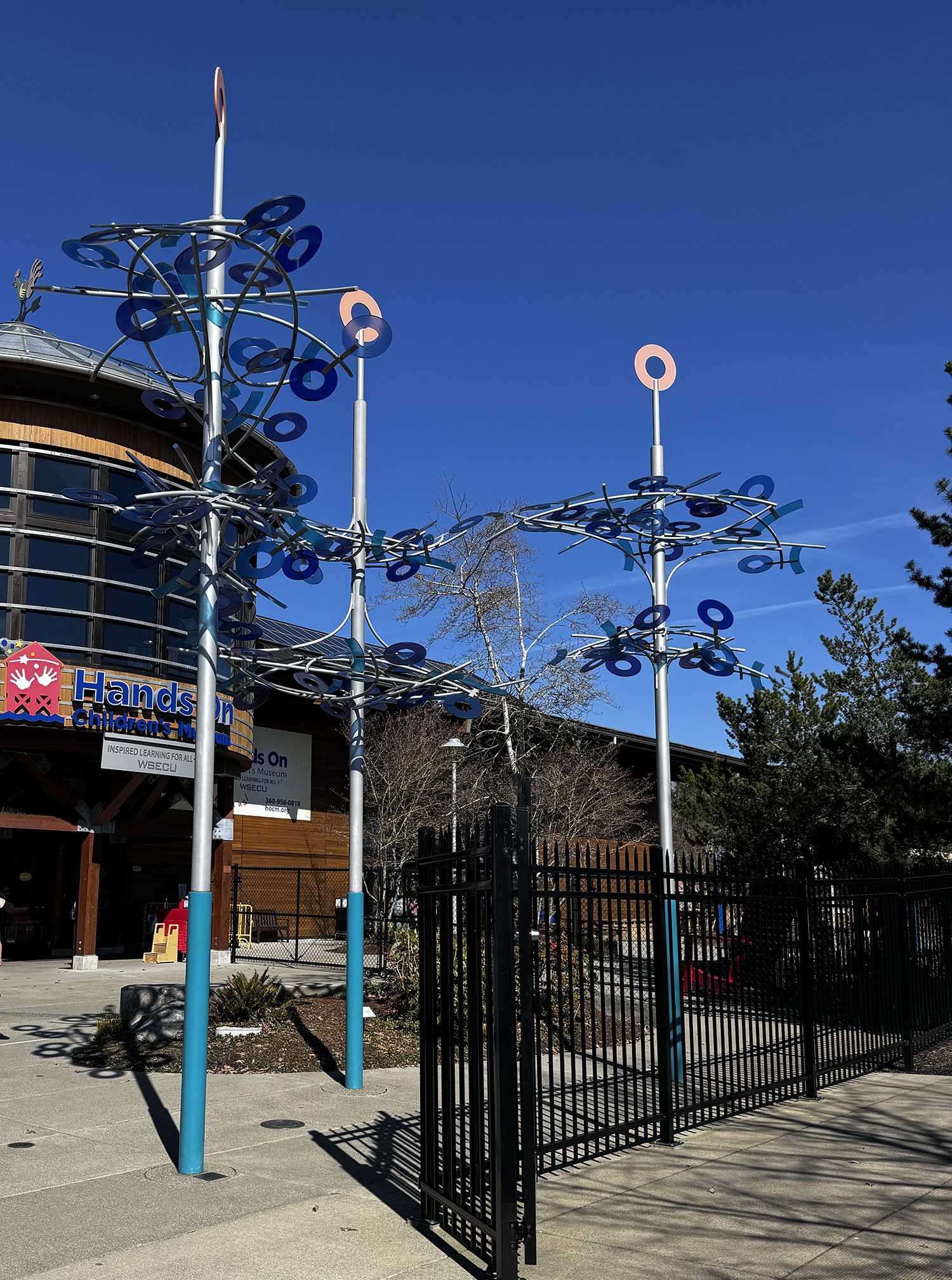
The Hands On Children’s Museum in Olympia. Photo by Mary Williams.
Hours are 9 a.m. to 5 p.m. Monday through Saturday and 10 a.m. to 5 p.m. on Sunday. Tickets cost $18.95 for 18 months and older, $17.95 for seniors 65 or older. You can save $1 per ticket by purchasing your ticket online.
The Olympia Historic District
The Olympia Historical Society and Bigelow House Museum website is a treasure trove of information about the Historic District and the many properties in it.
It includes an interactive map that allows you to plan your visit. Or, just start out and when you see someplace you want to learn more about, the map will allow you to click on an icon to find out more about what intrigues you.
Bigelow House Museum
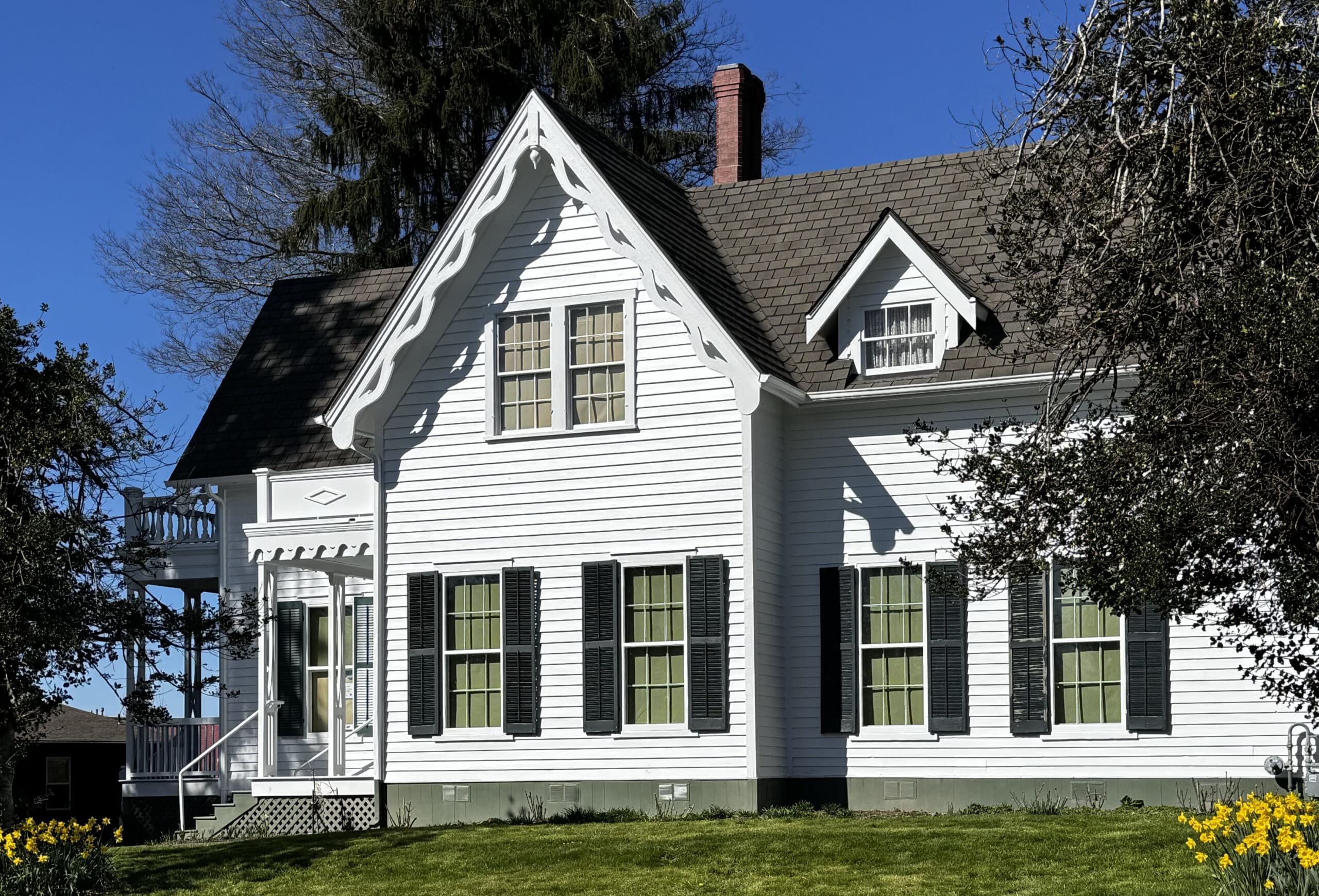
The Bigelow House in Olympia. Photo by Mary Williams.
Sometime shortly after 1854, Daniel and Ann Elizabeth White Bigelow began construction of their first home on a 640-acre property just east of Budd Inlet and near downtown Olympia. It was one of the first homes in the Olympia area and is a rare surviving example of the Carpenter Gothic-style architecture popular in rural America during the mid-1800s.
In 1992, the nonprofit Bigelow House Preservation Association was established to preserve and protect Bigelow House. BHPA purchased the house from descendants Daniel and Mary Ann Bigelow in 1994 and restored it to its territorial-era appearance. In 1995, Bigelow House opened as a museum. In 2013, the BHPA merged with the Olympia Historical Society, forming one organization that works together to preserve Olympia’s history.
The Bigelow House is located at 918 Glass Ave NE.
A 30-40 minute tour is available the first and second Sundays of the month at 1 p.m., 2 p.m. or 3 p.m. Tour capacity is limited to 10 people. The fee for the tour is $8 for adults, $5 for kids over 5 and seniors.
A nod to Women’s History Month
The Bigelow House is noteworthy because the Bigelows hosted Susan B. Anthony for dinner on October 18, 1871, while she was passing through Olympia on a speaking tour. The Bigelows and Anthony later worked together to form the Washington Territory Woman Suffrage Association. The state did not grant women the right to vote until 1910.
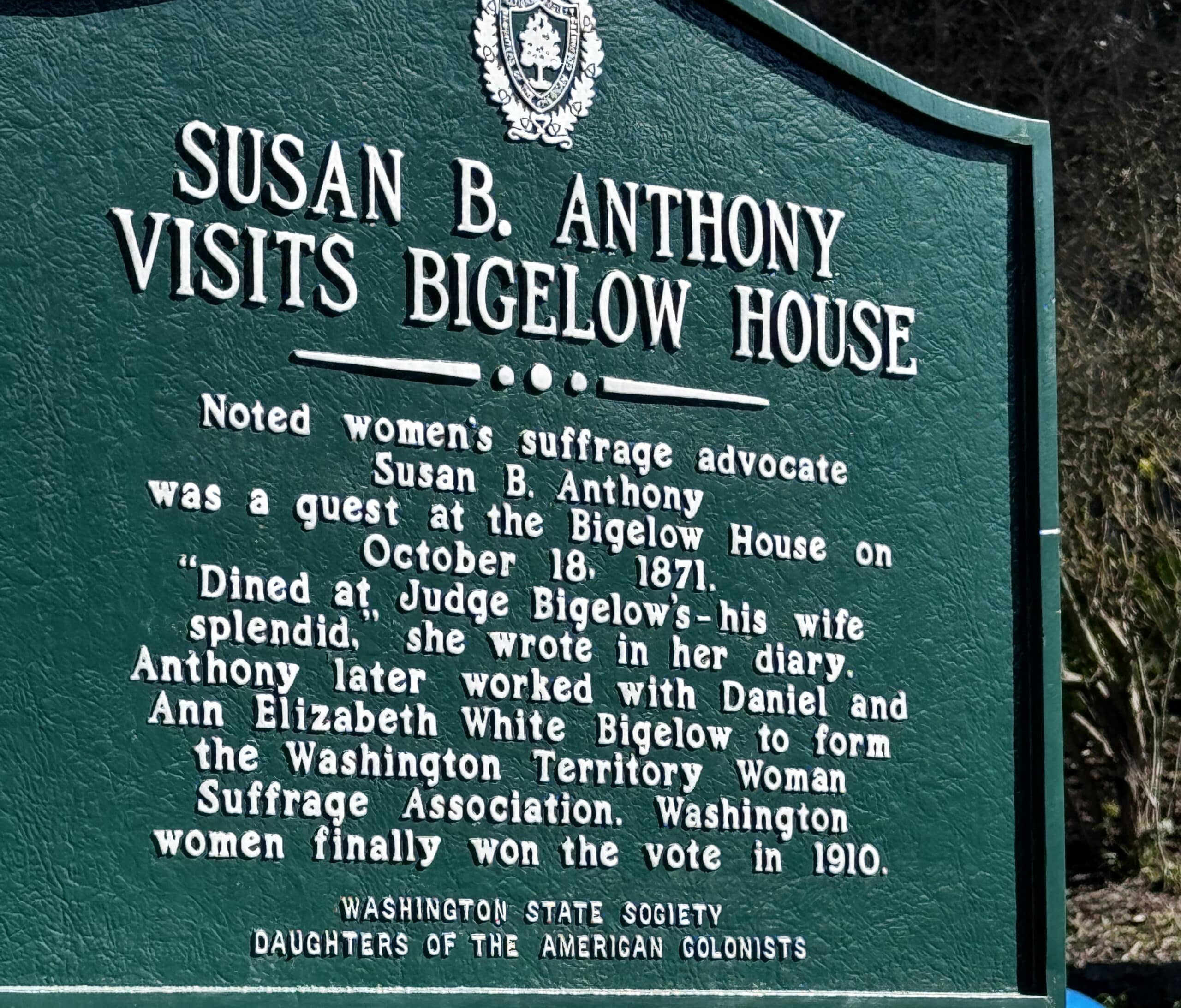
A sign commemorating suffragist Susan B. Anthony’s visit to Olympia and the Bigelow House. Photo by Mary Williams.
Gas prices are sky high, and a night in a hotel is approaching astronomically expensive. So, for the foreseeable future, I imagine many of you are going to find yourselves taking day trips rather than the road trip vacations we’ve grown to love.
This beautiful region in which we live is ripe with opportunities to explore new places, see new things, and learn a little something at the same time. I promise to keep the longest journeys to a one-way distance of under 200 miles. Whether you want to make it an overnight trip, a weekend, or just a very long day trip, we should be able to pull it off.
I hope you’ll grant me the honor of your virtual company as we travel these roads together. Happy trails!
